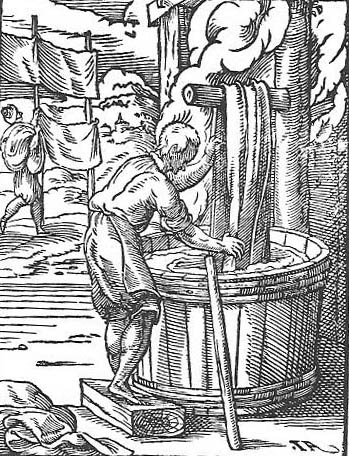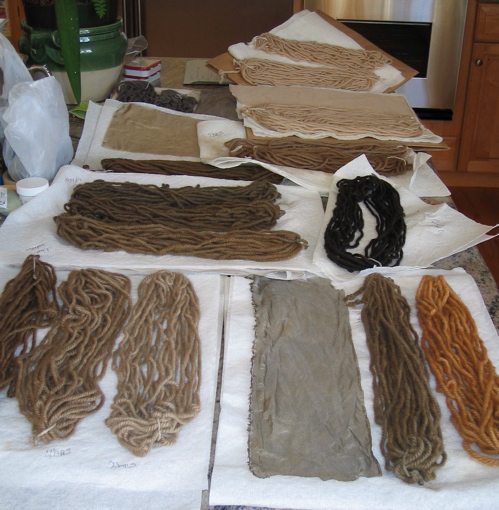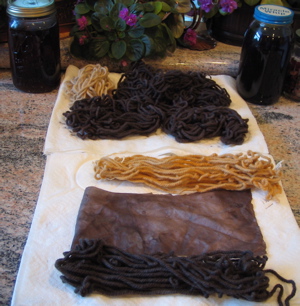 - Part 1 Tannic Acid Dyes
- Part 1 Tannic Acid Dyes
Needlework: |
|
Canvaswork - tent |
|
Pulled Thread (pdf) |
|
Goldwork Basics |
|
Surface Embroidery |
|
Smocking & Pleating (coming soon we hope) |
Clothing: |
Textiles & Thread: |
|
Lucet Basics - Square and Flat Braid |
|
Dyes: |
Cooking: |
Golden Poppy Competition & Entries: |
|
Tinctures: Dyes & Inks |
| Narrow Wares: Fingerloop Braiding (coming soon) |
 - Part 1 Tannic Acid Dyes
- Part 1 Tannic Acid DyesOnce the competition was over, I spent some time playing with onion skins, tumeric and copper dyes. More dying is on the horizon, but as I plan on growing the plants and spinning the wool - it may be a year or so out. Meanwhile here are my steps and results to date.
-- Project 1 – March 16, 2005: Walnut Hulls alone and with Post Mordanting—
A. Preparing the Dye Bath:
Take black walnut nuts and break up with a mallet. Remove the nut meat.
Take 4 oz of the walnut hulls and place in cheese cloth and tie shut. Place into 1 gallon of water in a stainless steel pot – sufficient to cover fabric and dyestuff package. Let soak 1 hour to soften up the shells. The pot was chosen as it would impart few if any impurities into the dye bath.
B. Preparing the Fabric:
Take 6 skeins of wool* and 2 silk swatches and immerse in a container of room temperature water. (fiber weight is approximately 4 ounces) Let soak 1 hour to ensure that the fibers are well opened up.
* 1 skein for this project is approximately 10 yards of Robin and Russ undyed but cleaned (scoured wool) which has been spun loosely.
C. Adding Fiber to Dye Bath:
Add the fiber to the dye bath. Bring to a boil. Turn off heat and let sit. Historically they may have boiled or simmered the fabric longer. (See Project 2 below)
At 14 hours remove 2 skeins of wool and 1 silk swatch. Rinse well. These will show what a “days” sitting in the dye vats would have produced from the natural color provided by the tannic acid from the hulls alone.
Also remove 1 quart of dye liquid. Immerse 2 skein of wool in container. Leave in an additional 10 hours. Remove and rinse well. This quart and skein was designed to show the natural color provided by the resulting tannic acid from the hulls alone and if the skeins were left in a longer period of time.
The tannic acid from the walnut hulls is self mordanting. Thus in the Innsbruck recipe, there is no additional mordant added. However, the green walnut outer skin has a lot of fresh tannic acid and may produce a deeper tint than the dried hulls alone.
 D. Post Mordanting:
D. Post Mordanting:
Bring pot back to a boil. Add 1 teaspoon ferrous sulfate (iron). Stir well and simmer for 30 minutes to ensure that the Iron is dissolved and the material is thoroughly infused with the Iron dye so the chemical reaction can occur. The chemical reaction between tannic acid and the tannic acid creates the black.
Let cool and remove the 2 skeins and silk swatch from the dye bath. Rinse thoroughly.
The choice of powdered Iron was to both a question of safety and convenience. The amount chosen was to reflect the least amount sufficient to affect the necessary chemical changes without having long term fiber deterioration.
My choice to post mordant was generated by a comment in another of the Innsbruck black dyes – oak gall. It says that if you want it darker add more black. In this case I opted for the ferrous sulfate to create a darker result.
E. Project Conclusions:
The non-mordanted fiber took on a color similar to tea dyeing which is another tannic acid dye. The color is a very light tan. When checked at the 1 hour and 3 hour points, it had taken very little color, nor did it darken overnight. The chemical reaction of the tannic acid and the ferrous sulfate produced a light gray/black.
The lightness of color could be due to either the lack of heat or the dye product to water ratio.
Picture: Back is Project 1, Middle is Project 2, and Front is Project 3 with iron alone on far right.
-- Project 2 – March 21, 2005: Walnut Hulls alone and Post – Mordanting with Iron – over heat
A. Preparing the Dye Bath:
Take black walnut nuts and break up with a mallet. Remove the nut meat.
Take 4 oz of the walnut hulls and place in cheese cloth and tie shut. Place into 1 gallon of water in a stainless steel pot – sufficient to cover fabric and dyestuff package. Let soak 1 hour to soften up the shells.
B. Preparing the Fabric:
Take 4 skeins of wool and silk swatch. No pre-wetting was done to see if the dye would take differently.
C. Adding Fiber to Dye Bath:
Add the fiber to the dye bath. Bring to a boil and then reduce to a simmer.
At 2 hours remove a skein of wool. Rinse well.
At 4 hours remove a skein of wool. Rinse well.
At 8 hours remove a skein of wool and silk swatch. Rinse well. These will show what a “days” simmering in the dye vats would have produced from the natural color provided by the tannic acid from the hulls alone.
D. Post Mordanting:
Bring pot back to a boil. Add 1/4 teaspoon ferrous sulfate (iron). Stir well and simmer for 30 minutes to ensure that the Iron is dissolved and the material is thoroughly infused with the Iron dye so the chemical reaction can occur. The chemical reaction between tannic acid and the tannic acid creates the black. Let cool and remove the skein from the dye bath. Rinse thoroughly.
Although the tannic acid from the walnut hulls is self mordanting, and the color was a deep brown, I was curious to see the effect of adding the iron (additional “black”) as in the Innsbruck Manuscripts and in others for doing oak galls.
E. Project Conclusions:
Keeping the heat on the dye bath both allowed more tannic acid to be released from the hulls and the fibers to absorb more of the dye. The 2 hour skein is a nice medium brown with the 4 hour skein being slightly darker. The 8 hour skein and silk swatch is a rich “walnut” brown. Adding the iron created an almost instant reaction and the result is a deep rich black.
-- Project 3: Walnut Hulls with Pre-Mordanting —
A. Preparing the Dye Bath:
Take black walnut nuts and break up with a mallet. Remove the nut meat.
Take 4 oz of the walnut hulls and place in cheese cloth and tie shut. Place into 1 gallon of water in a stainless steel pot – sufficient to cover fabric and dyestuff package. Let soak 1 hour to soften up the shells.
Bring to a boil and let simmer until level of preferred color depth is reached. This took about 8 hours.
There were 3 skeins of wool that were removed at 2 hours, 4 hours and 8 hours. This was used to determine the depth of color obtained in the dye bath.
B. Pre-Mordanting:
In a separate pot take 2 quarts water (a sufficient amount to cover the fiber) and bring to boil. Add 1 teaspoon of Ferrous Sulfate (Iron) and stir to dissolve. Add in 6 oz of fiber – 6 skeins of wool and silk swatch. Simmer for 30 minutes to ensure that the Iron is dissolved and the material is thoroughly infused with the Iron dye.
Remove 1 skein and wash thoroughly. This skein will show the amount of iron coloration alone.
C. Adding Mordanted Fiber to Dye Bath:
Remove skeins and silk to the dye bath. Bring dye bath to a boil. Let simmer. After 1 hour remove 2 skeins and silk swatch. Rinse well.
After 4 hours remove 2 skeins and rinse well.
D. Project Conclusions:
The dye bath this time was not yielding quite the same depth of color as in Project 2, however the browns were close enough to use the same timing sequence as in the prior project.
The premordanted fiber reached a depth of brown color similar to the walnut alone at the 8 hour level, but at the 1 hour mark. While it has a bit of a blacker tinge to it, it is not the rich black of the post mordanted fiber. At the 4 hour mark, the fiber was a little bit darker and a bit blacker, but still lacked the richness of the post mordanted skein.
 Berry Vine - Project Notes
Berry Vine - Project NotesA. Preparing the Dye Bath:
Wash well the leaves and stems of a berry vine – Rubus family. Cut into 3-6” pieces. – Note that the amount filled a small tub (15”x12”x6”) but was loosely packed.
Place leaves and stems in 12 quart stainless steel pot. Cover with water – it took 3 gallons. The pot was chosen as it would impart few if any impurities into the dye bath.
Bring to a boil and simmer for 4 hours. Remove plant material from dye bath. The 4 hours was determined by the coloration of the resulting dye.
No Mordant:
Remove 1 quart of dye liquid. Immerse 1 skein of wool* in container. Leave in overnight. Remove and rinse well. This quart and skein was designed to show the natural color provided by the resulting tannic acid from the plant materials alone.
* 1 skein for this project is approximately 10 yards of Robin and Russ undyed but cleaned (scoured wool) which has been spun loosely.
B. Pre-Mordanting - Iron:
In a separate pot take 3 quarts water (a sufficient amount to cover the fiber) and bring to boil. Add 1.5 teaspoons of Ferrous Sulfate (Iron) and stir to dissolve. Add in 4 oz of fiber – 6 skeins of wool and silk swatch. Simmer for 30 minutes to ensure that the Iron is dissolved and the material is thoroughly infused with the Iron dye.
Remove 1 skein and rinse thoroughly. This skein will show the effect of the dyeing from the Iron alone. The coloration will depend on the amount of Iron absorbed into the fabric.
The choice of powdered Iron was to both a question of safety and convenience. The amount chosen was to reflect the least amount sufficient to affect the necessary chemical changes. I was aiming to not have long term fiber deterioration.
C. Adding Mordanted Fiber to Dye Bath:
Remove other skeins and silk to the dye bath. Bring dye bath to a boil. Turn off the heat. Historically they may have boiled or simmered the fabric longer. However, once the chemical reaction sets in there is little more that will happen aside from the amount of absorption of the dye into the fiber (see Project Conclusions).
Remove 1 skein and silk swatch after 1 hour. Rinse well.
Remove 2 skeins after 3 hours. Rinse well.
Remove remaining 2 skeins after leaving overnight (15 hours). Rinse well.
D. Adding Dyed Fiber to Mordant Liquid:
Add one skein of fiber dyed in the berry vine to the iron mordanting water. The color change was near instant to black. Remove and rinse well.
D. Project Conclusions:
The non-mordanted fiber took on a color similar to tea dyeing which is another tannic acid dye. The color is a light tan with slight orange tones. When checked at the 1 hour and 3 hour points, it had taken very little color, but it seemed to darken overnight.
The mordanted fiber took on a brick color but in itself was not dark. It has taken on more color after drying and being exposed to the air.
The chemical reaction of the tannic acid and the ferrous sulfate produced a light black. At the 1 hour point the reaction had set in. At the 3 hour point, there was a little more color but there does not seem to be any difference between the 3 hour and overnight. The uneven mordanting of the silk swatch caused some blotchiness in the color. The black has darkened with drying and being exposed to the air. The color is a blue/brown black.
Return to the Main Page for Bayrose.org
All Rights to Pictures and Text Reserved by Robin L. Berry, unless noted otherwise - 2007.